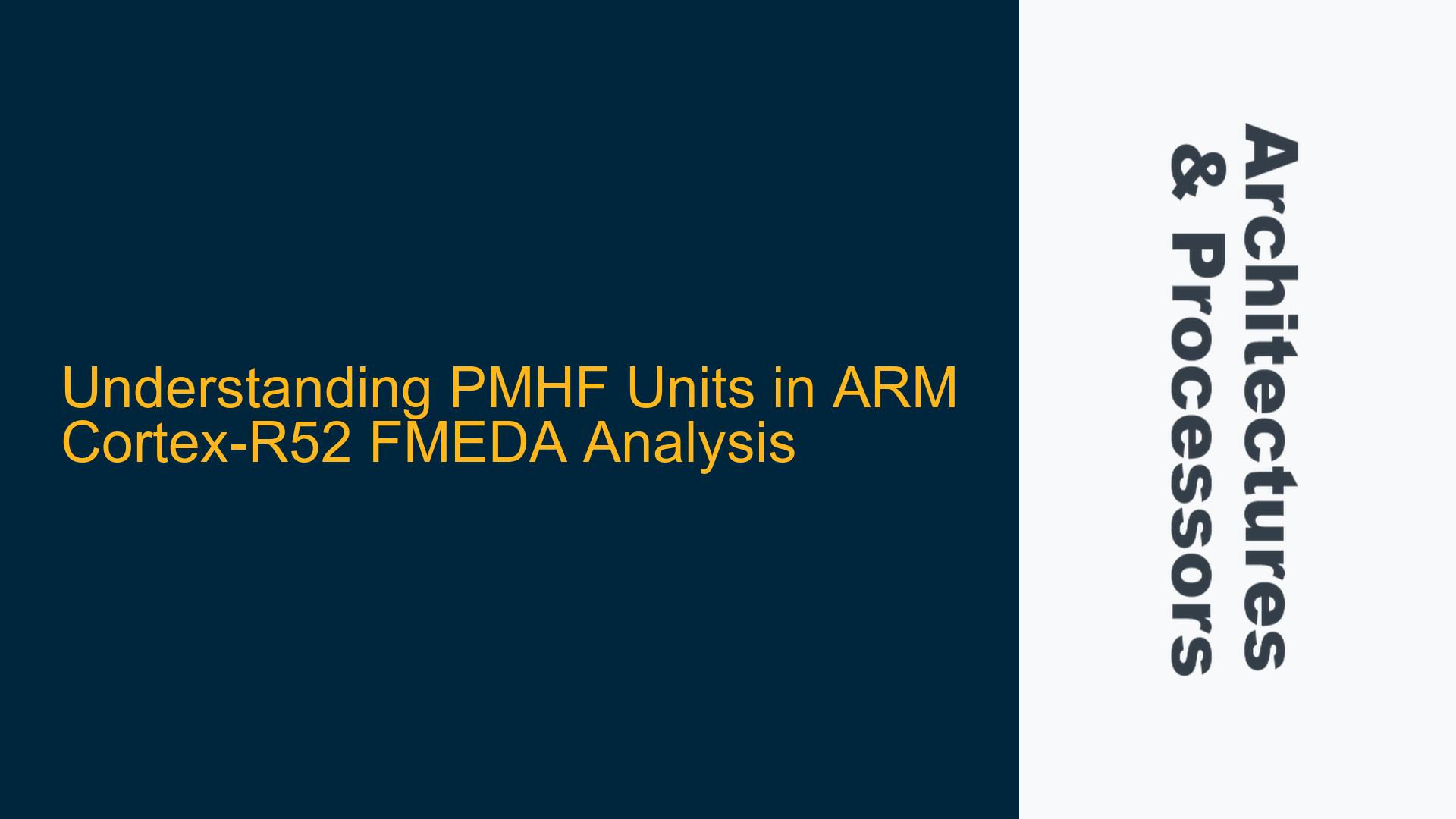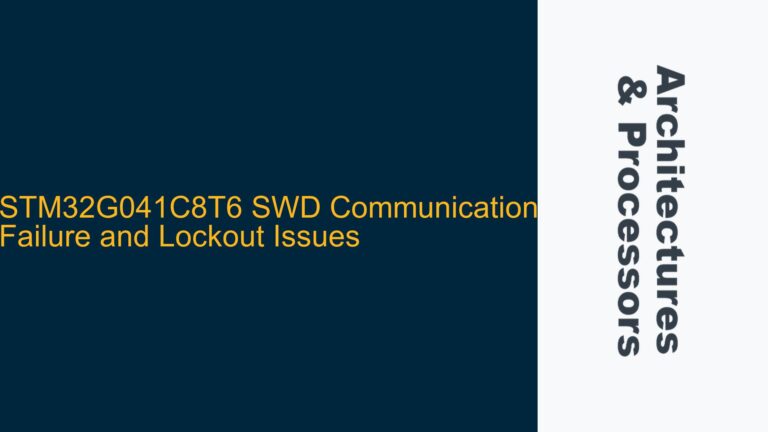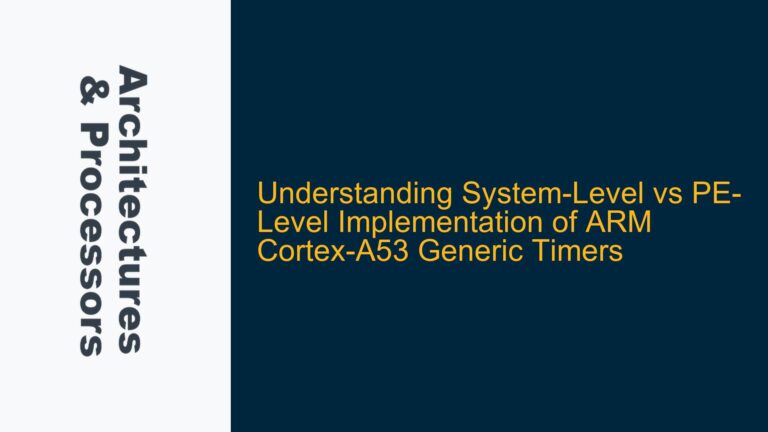ARM Cortex-R52 PMHF Calculation and Unit Clarification
The Probabilistic Metric for Hardware Failure (PMHF) is a critical metric in Functional Safety analysis, particularly when evaluating the reliability of systems designed to meet ISO 26262 or similar safety standards. In the context of the ARM Cortex-R52 processor, PMHF is used to quantify the likelihood of random hardware failures over a specified period, typically expressed in units of Failure In Time (FIT). One FIT represents one failure per billion (10^9) hours of operation. However, the specific unit of PMHF in the ARM Cortex-R52 FMEDA (Failure Modes, Effects, and Diagnostic Analysis) report can sometimes be ambiguous, leading to confusion during system-level safety analysis.
The ARM Cortex-R52 FMEDA provides a detailed breakdown of the failure rates for various components within the processor, including the CPU core, memory interfaces, and peripherals. These failure rates are aggregated to compute the overall PMHF for the processor. The PMHF value is a key input for system-level safety analysis, as it helps determine whether the system meets the target safety goals, such as Automotive Safety Integrity Level (ASIL) requirements.
When integrating the ARM Cortex-R52 into a System-on-Chip (SoC), the PMHF value from the FMEDA must be combined with failure rates from other components to calculate the overall PMHF for the SoC. This requires a clear understanding of the units used in the FMEDA report. If the PMHF value is not properly interpreted, it can lead to significant errors in the system-level safety analysis, potentially resulting in non-compliance with safety standards.
Ambiguity in PMHF Units and Its Impact on System-Level Analysis
The primary issue arises when the unit of PMHF in the ARM Cortex-R52 FMEDA is not explicitly stated or is misinterpreted. While FIT is the most common unit for PMHF, other units such as failures per million hours or failures per thousand hours may also be used in certain contexts. This ambiguity can lead to incorrect calculations when integrating the ARM Cortex-R52 PMHF into the overall SoC FMEDA.
For example, if the PMHF value in the ARM Cortex-R52 FMEDA is provided in failures per million hours, but the system-level analysis assumes FIT (failures per billion hours), the resulting PMHF for the SoC will be off by a factor of 1,000. This discrepancy can have severe consequences, particularly in safety-critical applications where even small errors in failure rate calculations can compromise the integrity of the system.
To avoid such errors, it is essential to verify the unit of PMHF in the ARM Cortex-R52 FMEDA and ensure consistency with the units used in the system-level analysis. This may involve consulting the FMEDA documentation, reaching out to the IP provider, or performing additional calculations to convert the PMHF value to the desired unit.
Resolving PMHF Unit Ambiguity and Ensuring Accurate Safety Analysis
The first step in resolving the ambiguity in PMHF units is to carefully review the ARM Cortex-R52 FMEDA documentation. The documentation should specify the unit of PMHF, typically in the form of a footnote or a section dedicated to explaining the metrics used in the analysis. If the unit is not explicitly stated, it may be necessary to infer it from the context or consult with the IP provider for clarification.
Once the unit of PMHF is confirmed, the next step is to ensure consistency with the units used in the system-level analysis. If the ARM Cortex-R52 PMHF is provided in a different unit than the one used in the SoC FMEDA, a conversion factor must be applied. For example, if the ARM Cortex-R52 PMHF is given in failures per million hours and the SoC FMEDA uses FIT, the PMHF value must be multiplied by 1,000 to convert it to FIT.
In addition to unit conversion, it is also important to consider the impact of diagnostic coverage on the PMHF value. Diagnostic coverage refers to the effectiveness of the diagnostic mechanisms in detecting and mitigating hardware failures. The ARM Cortex-R52 FMEDA typically provides PMHF values for different levels of diagnostic coverage, such as 90%, 99%, or 99.9%. The system-level analysis must use the PMHF value that corresponds to the diagnostic coverage achieved by the implemented safety mechanisms.
To ensure accurate safety analysis, the following steps should be taken:
-
Review the ARM Cortex-R52 FMEDA Documentation: Carefully examine the FMEDA report to identify the unit of PMHF and any additional information related to diagnostic coverage or failure rate calculations.
-
Verify Unit Consistency: Compare the unit of PMHF in the ARM Cortex-R52 FMEDA with the units used in the system-level analysis. If there is a discrepancy, apply the appropriate conversion factor to align the units.
-
Account for Diagnostic Coverage: Select the PMHF value that corresponds to the diagnostic coverage achieved by the safety mechanisms implemented in the system. If the diagnostic coverage is not explicitly stated, perform a detailed analysis to estimate the coverage and select the appropriate PMHF value.
-
Integrate PMHF into System-Level Analysis: Combine the ARM Cortex-R52 PMHF with the failure rates of other components in the SoC to calculate the overall PMHF. Ensure that all failure rates are expressed in the same unit and that the diagnostic coverage is consistently applied across all components.
-
Validate Results Against Safety Goals: Compare the calculated PMHF with the target safety goals, such as ASIL requirements, to determine whether the system meets the required level of safety. If the PMHF exceeds the target, identify the components with the highest failure rates and implement additional safety mechanisms to reduce their contribution to the overall PMHF.
By following these steps, the ambiguity in PMHF units can be resolved, and accurate safety analysis can be performed for systems incorporating the ARM Cortex-R52 processor. This ensures compliance with safety standards and enhances the reliability of safety-critical applications.
Practical Considerations for PMHF Calculation in ARM Cortex-R52-Based Systems
In addition to resolving unit ambiguity, there are several practical considerations that must be taken into account when calculating PMHF for ARM Cortex-R52-based systems. These considerations include the impact of operating conditions, the role of software in diagnostic coverage, and the need for continuous monitoring and updates to the FMEDA.
Operating Conditions: The failure rates of electronic components, including the ARM Cortex-R52 processor, can vary significantly depending on the operating conditions, such as temperature, voltage, and humidity. The FMEDA typically provides failure rates under standard operating conditions, but these rates may need to be adjusted for the specific operating environment of the system. For example, if the system operates at elevated temperatures, the failure rates may increase, leading to a higher PMHF. It is important to account for these variations when performing system-level safety analysis.
Software Diagnostic Coverage: While the ARM Cortex-R52 FMEDA provides PMHF values based on hardware diagnostic mechanisms, the overall diagnostic coverage of the system also depends on the software implemented on the processor. Software-based diagnostics, such as periodic self-tests or runtime checks, can significantly enhance the diagnostic coverage and reduce the PMHF. However, the effectiveness of software diagnostics must be carefully evaluated, as they may introduce additional complexity and potential sources of failure.
Continuous Monitoring and Updates: The FMEDA is a snapshot of the failure rates and diagnostic coverage at a specific point in time. As the system evolves, the failure rates and diagnostic coverage may change due to design modifications, updates to the operating environment, or improvements in diagnostic mechanisms. It is essential to continuously monitor the system and update the FMEDA to reflect these changes. This ensures that the PMHF remains accurate and that the system continues to meet the target safety goals.
Integration with Other Safety Analysis Techniques: PMHF is just one of several metrics used in safety analysis. Other techniques, such as Fault Tree Analysis (FTA) and Failure Modes and Effects Analysis (FMEA), provide complementary insights into the system’s reliability and safety. Integrating PMHF with these techniques can provide a more comprehensive understanding of the system’s safety profile and help identify potential weaknesses that may not be apparent from PMHF alone.
Tool Support for PMHF Calculation: Calculating PMHF for complex systems can be a challenging task, particularly when dealing with multiple components and varying diagnostic coverage. Specialized tools, such as safety analysis software, can automate many of the calculations and ensure consistency across the analysis. These tools can also provide visualization capabilities, making it easier to identify trends and anomalies in the failure rates.
By considering these practical aspects, engineers can ensure that the PMHF calculation for ARM Cortex-R52-based systems is accurate, reliable, and aligned with the overall safety goals of the system. This not only enhances the safety of the system but also simplifies the certification process, as the safety analysis is based on a thorough and well-documented methodology.
Conclusion
The Probabilistic Metric for Hardware Failure (PMHF) is a critical metric in the safety analysis of systems incorporating the ARM Cortex-R52 processor. However, the ambiguity in PMHF units can lead to significant errors in system-level safety analysis, potentially compromising the integrity of safety-critical applications. By carefully reviewing the ARM Cortex-R52 FMEDA documentation, verifying unit consistency, accounting for diagnostic coverage, and integrating PMHF into the system-level analysis, engineers can resolve this ambiguity and ensure accurate safety analysis.
In addition to resolving unit ambiguity, practical considerations such as operating conditions, software diagnostic coverage, continuous monitoring, and integration with other safety analysis techniques must be taken into account. By addressing these considerations and leveraging specialized tools, engineers can enhance the reliability and safety of ARM Cortex-R52-based systems, ensuring compliance with safety standards and achieving the desired level of safety integrity.
Ultimately, a thorough and well-documented approach to PMHF calculation is essential for the successful development and certification of safety-critical systems. By following the guidelines outlined in this post, engineers can navigate the complexities of PMHF analysis and deliver systems that meet the highest standards of safety and reliability.






